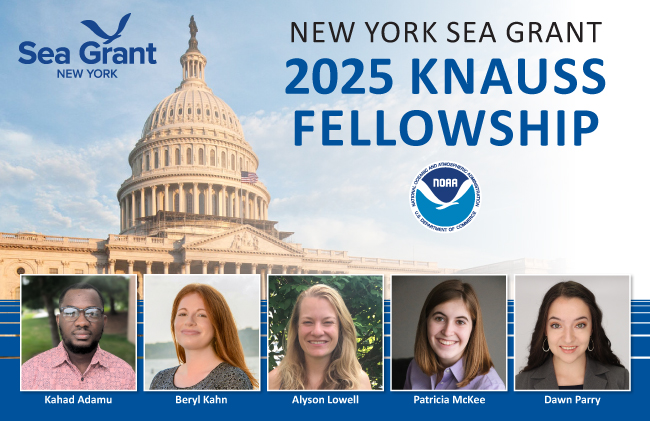
New York Sea Grant's 2025 Knauss Fellows. Credit: Illustration by Maria Beccari/NYSG
— By Chris Gonzales, Freelance Science Writer, New York Sea Grant
(with assistance from Rose Weldon, NYSG's Science Writer)
New York, NY, March 10, 2025 - New York Sea Grant (NYSG) congratulates five phenomenal fellows from New York universities for successfully competing to be a member of the 46th class of Sea Grant's John A. Knauss Marine Policy Fellowship (Knauss Fellowship).
Among the fellowship program's 88 new cohort of fellows are: Kahad Adamu (University at Buffalo), Beryl Kahn (City University of New York), Alyson Lowell (Stony Brook University), Patricia McKee (Pace University), and Dawn Parry (Cornell University).
Through this one year hands-on opportunity that started February 1st, each is applying their skills and experience in coastal science, law, and policy to address key issues in marine and Great Lakes sustainable use and conservation. Four have placements in the executive branch (Adamu, Kahn, McKee, and Parry) and one in the legislative branch (Lowell) of the U.S. Government:
• Adamu — NOAA OAR / National Sea Grant Office
• Kahn — NOAA NOS National Centers for Coastal Ocean Science
• McKee — U.S. Committee on the Marine Transportation System
• Parry — U.S. Department of Energy, Wind Energy Technologies Office
• Lowell — Senator Lisa Murkowski (R-AK)
“Please join me in welcoming Kahad, Beryl, Patricia, Dawn, and Ally to the Sea Grant family”, said Becky Shuford, Director of New York Sea Grant. “With positions across the executive and legislative branches, they are each poised to bring their expertise and skills to bear across diverse coastal and marine domains and industries - from transportation to energy, to coastal community-based science and outreach, to informing the development of policy and legislation. We are beyond excited for the adventure these five dynamic, passionate, and visionary new Knauss Fellows are embarking on, on behalf of the Nation’s coastal communities, economies, and environments. They are sure to make a transformational impact.”
NYSG’s 2025 Knauss Finalists: In Their Words
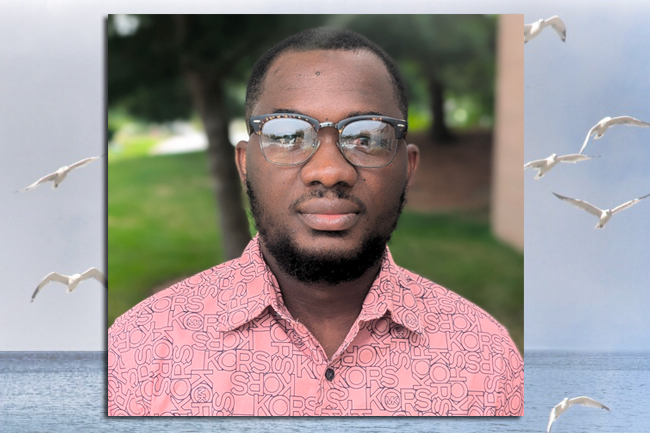
Headshot of Kahad Adamu. Credit: Enoch Frimpong
Kahad Adamu
Knauss Executive Fellow placement: NOAA Oceanic and Atmospheric Research / National Sea Grant Office
Student seeking a PhD at University at Buffalo
Kahad Adamu — currently working toward his Ph.D. in Urban and Regional Planning at the State University of New York, University at Buffalo — places communication as a prominent part of his list of skills. Sharing scientific findings with the public is also one of his strengths. He has prepared policy briefs and communication strategies for non-governmental organizations and community groups, employing elements such as storytelling and rhetoric in his work.
His interests have taken him to Dar es Salaam, Tanzania, where he worked with community groups to develop a sustainable financial model to support a community-led sanitation project. He has also worked on land rights document projects in Ghana, which sought to enlighten the customary land rights holders on the ways to secure their land rights.
Adamu says he would like to devote his energies to water resource conservation, governance, and sustainability. In particular, he would like to address water-related issues that have been brought about by human choices.
His strong suits are data analysis, GIS (geographic information systems) technology, coupled with problem-solving and critical thinking skills. Furthermore, his communication skills and adaptability enable him to navigate an interdisciplinary world of marine issues and policy.
“My work focuses on streamlining policy processes and overcoming institutional barriers to improve watershed governance and planning in the United States and Global South,” Adamu said. “I collaborate closely with local communities and organizations to ensure that their needs align with policy goals and outcomes.”
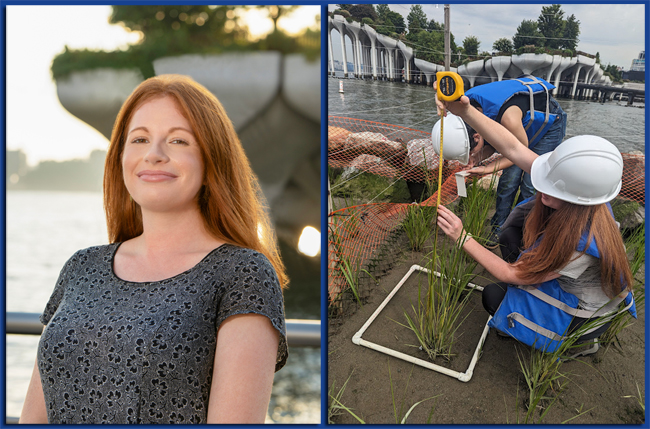
(at left) Beryl Kahn, in front of Little Island, New York. Credit: Ron Wallace; (at right) Kahn measures Spartina grass in a newly restored marsh site at Gansevoort Peninsula, the newest part of Hudson River Park. Credit: Mary Alldred
Beryl Kahn
Knauss Executive Fellow placement: NOAA NOS National Centers for Coastal Ocean Science
Student seeking a PhD at City University of New York
Beryl Kahn is a PhD candidate at the City University of New York, and until starting the Knauss fellowship, was an adjunct lecturer in the Natural Studies Department at Baruch College.
Her past work has dealt with water quality and shoreline resilience, including how salt marshes can remove excessive nitrogen from water. Kahn has also studied the impacts of sea level rise-induced erosion and nutrient loading on the health of these systems, including the finding that marshes that have converted to mudflats actually release nutrients instead of removing them.
Kahn adds that she has been sharing her knowledge with the next generation, not only teaching high school students about marine pollution, but also developing a curriculum on the topic. In class, she gave students containers of water “contaminated” with canola oil, food coloring, and paper scraps, and students then had to develop strategies to clean the water.
In the long-term, Kahn’s aim is to become a research scientist at NOAA’s National Ocean Service, with the mission of enhancing urban coastline sustainability. She hopes to use her research and data analysis skills to further the interconnected objectives to improve water quality and protect the environment.
“There’s so much exciting research out there that explores harnessing nature’s own processes to improve our coasts,” Kahn said. “With the Knauss fellowship, I hope to contribute to innovative strategies that increase shoreline resilience and help coastal communities adapt to climate change.”
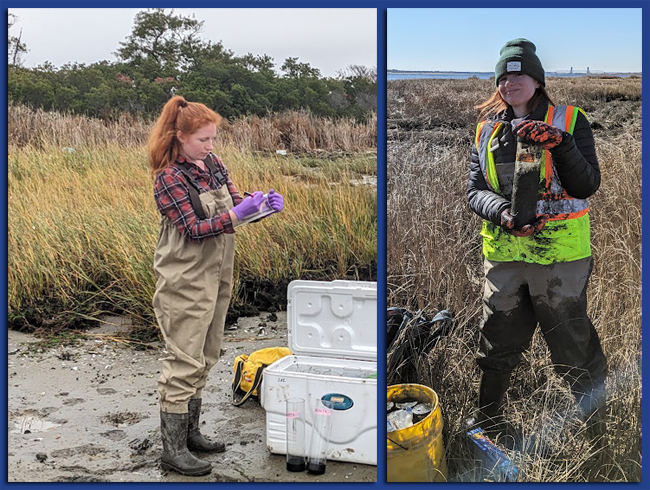
(at left) Kahn labels a corer in preparation to take a sediment sample from a salt marsh in Jamaica Bay; (at right) Kahn holds a sediment core from a degrading marsh in Jamaica Bay, for a study that compares nitrogen cycling in living marshes with eroded former marsh sediments. Credit: Chester Zarnoch
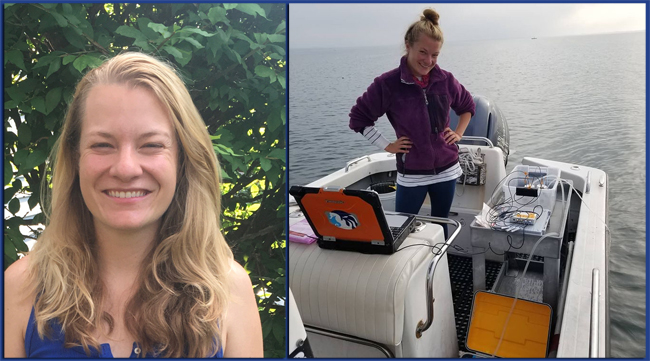
(at left) Headshot of Alyson Lowell; (at right) While working in the field, Lowell assesses scallop respiration across a gradient of differing densities of eelgrass (Zostera marina L.) Credit: Bradley Peterson
Alyson Lowell
Knauss Legislative Fellow placement: Senator Lisa Murkowski (R-AK)
Student seeking PhD at Stony Brook University, School of Marine and Atmospheric Sciences
Alyson Lowell — currently a PhD candidate studying seagrasses and associated organisms — studies how seagrasses and calcifiers respond to stressors like coastal acidification, warming sea surface temperatures, and emerging diseases. She seeks to develop and support holistic restoration programs targeted at enhancing sustainability and conservation of coastal regions.
Her research has allowed her to document how environmental variability has affected coastal ecosystems and local stakeholders both domestically and abroad. In her work with the non-profit organization Remote Ecologist she has guided local stakeholders to restore degraded coastal reefs in the Caribbean islands of Colombia. Closer to home, in New York’s Shinnecock Bay, she documented how coastal acidification is affecting nearshore communities with the hope of using this information to support commercial fishermen.
Lowell added that she aspires to join a community of scientists who are at the nexus of science and policy.
“I am thrilled to be selected as a 2025 Knauss fellow,” Lowell said. “I plan to apply freely shared knowledge to accelerate our understanding of ecosystem resiliency in the face of environmental variability.”
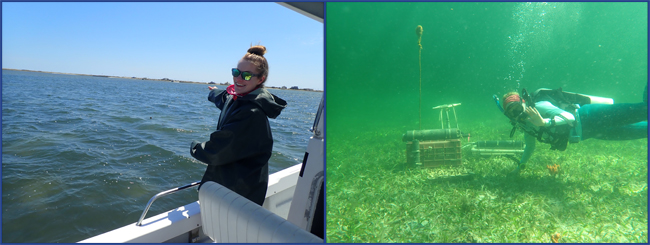
(at left) On the water in Western Shinnecock Bay, New York, Lowell points to an eelgrass meadow she studied extensively during her PhD research; (at right) During a field experiment in Bocas Del Toro, Panama, Lowell studies how turtle grass (Thalassia testudinum) modulates carbonate chemistry. She is working to detect if there is an associated benefit for reef forming corals. Credit: Bradley Peterson
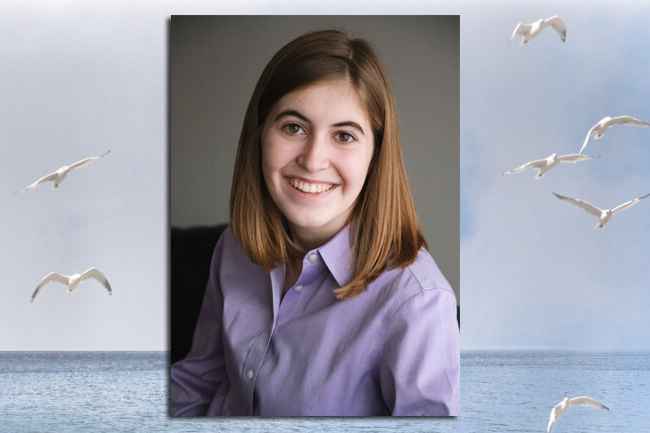
Headshot of Patricia McKee. Credit: Jasper & Fern in Winston-Salem, North Carolina
Patricia McKee
Knauss Executive Fellow placement: U.S. Committee on the Marine Transportation System
Student seeking a JD at Pace University, Elisabeth Haub School of Law
This May, Patricia McKee will graduate from the Elisabeth Haub School of Law at Pace University with an Advanced Certificate in Environmental Law. A proud North Carolinian, she earned her Bachelor of Science in Natural Resources from North Carolina State University (NC State).
While attending NC State, McKee served as a research assistant on a project examining the impact of compounded crises on tourism-dependent communities, with a focus on the role of local media in disseminating disaster-related information. This experience sparked her interest in the complex intersection of environmental and socio-economic issues, and motivated her application to law school.
At Haub Law, McKee continued studying community resilience, researching how municipal governments can exercise their land use authority to improve public health outcomes. She was also a Summer Research Associate at the National Sea Grant Law Center, investigating thin-layer placement, a method for restabilizing subsiding wetlands using dredged material.
“I am honored to be chosen as a 2025 John A. Knauss Marine Policy Fellow and am excited to meet my cohort,” McKee said. “Through this Fellowship, I will refine my ability to integrate scientific research with policy development, preparing myself for a career in public service.”
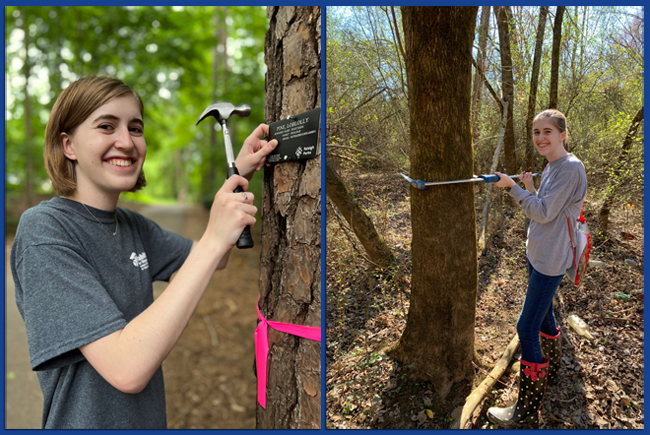
(at left) For McKee’s college honors project, she installed interactive tree identification signs at a local park. Credit: Emily Tomblin; (at right) McKee and her peers survey forested areas in riparian zones around Raleigh, North Carolina to gauge damage from invasive insects, specifically the emerald ash borer. In this photo, they are measuring diameter at breast height of affected ash trees using a caliper. Credit: Emery Lang
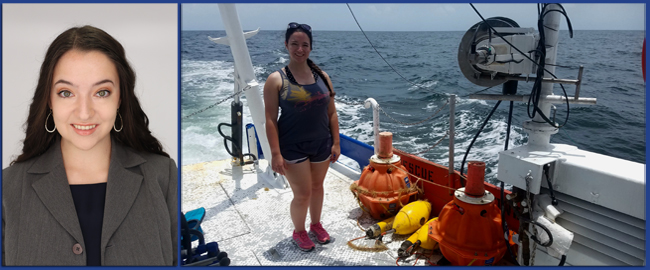
(at left) Headshot of Dawn Parry; (at right) As part of her graduate work at Cornell, Parry helps recover acoustic recording devices (orange gear) that have been listening for whales and monitoring ocean noise in the Gulf of Mexico. Credit: Derek Jaskula
Dr. Dawn Parry
Knauss Executive Fellow placement: U.S. Department of Energy, Wind Energy Technologies Office
Recent PhD graduate, Cornell University
Dawn Parry recently completed her PhD at Cornell University in natural resources and the environment, and believes it is essential for scientists to consistently collect routine data in order to address biodiversity loss.
Parry's PhD work encompassed bioacoustics, ecology, and policy, and she also prioritized science communication and public outreach.
One of her dissertation projects involved determining how much noise human activities add to the underwater environment of the Gulf Coast, data that can be used to assess human impacts on marine life. She also participated in a Bermuda-based project to provide seasonal occurrence data for whales and economically important fish, and shared acoustic data from the project with undergraduate mentees, who analyzed for toothed whale presence.
Prior to her PhD, Parry worked on a Sea Grant effort to determine which estuaries contribute most to the New Jersey striped bass population.
Above all else, Parry says, it’s important to communicate science to the public.
“I hope to leverage the best available science along with public education and outreach to create informed policy,” Parry said. “My overall goal is to benefit the marine environment, coastal communities, and the economy.”
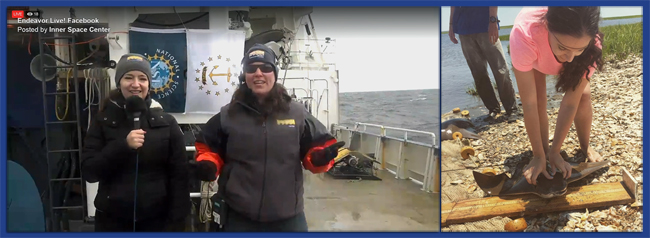
(at left) Parry participates in a live, ship-to-shore webinar from the University of Rhode Island's R/V Endeavor. The purpose was to educate the public about their search for critically endangered North Atlantic right whales. It was broadcast on social media by the University of Rhode Island Inner Space Center. Credit: URI Inner Space Center (at right) Parry measures a cownose ray as part of a population study with the Rutgers University Marine Field Station. Credit: Alexandra Schneider
More Info: Knauss Fellowship
“This year’s Knauss Fellowship cohort exemplifies the passion and expertise necessary to address the evolving challenges facing our coasts and oceans,” remarked Dr. Jonathan Pennock, Director of the National Sea Grant College Program. “We are confident that their dedication to serving through science will lead to innovative solutions that sustain coastal and marine resources and communities for future generations.”
This year, for the first time in program history, all eligible Sea Grant programs are represented by a diverse cohort of 88 early-career professionals who will spend the next year working alongside federal agencies or legislative offices in Washington, D.C., applying their academic expertise to critical marine, coastal and Great Lakes policy issues.
As in previous years, this year’s finalists were selected through a competitive process that involved review panels composed of national experts in marine science, policy and education. Over the past 45 years, the Knauss Fellowship has supported more than 1,660 students who have significantly contributed to environmental policy and management and built lasting careers.
Students enrolled in or have recently completed master’s, Juris Doctor (J.D.), and Doctor of Philosophy (Ph.D.) programs with a focus and/or interest in marine and coastal science, policy or management can apply to the John A. Knauss Marine Policy Fellowship Program via one of 34 state Sea Grant programs. Applicants who are successful at the state level advance, and their applications are reviewed by a national panel.
You’ll find further details about the fellowship at www.seagrant.noaa.gov/Knauss, you can keep up with current and previous Knauss fellows from across the country at www.seagrant.noaa.gov/knauss-blog, and a synopsis of the fellowship can be found in a one-and-a-half minute long video clip at https://bit.ly/Knauss-video.
More Info: New York Sea Grant
Established in 1966, the National Oceanic and Atmospheric Administration (NOAA)’s National Sea Grant College Program promotes the informed stewardship of coastal resources in 34 joint federal/state university-based programs in every U.S. coastal state (marine and Great Lakes) and Puerto Rico. The Sea Grant model has also inspired similar projects in the Pacific region, Korea and Indonesia.
Since 1971, New York Sea Grant (NYSG) has represented a statewide network of integrated research, education and extension services promoting coastal community economic vitality, environmental sustainability and citizen awareness and understanding about the State’s marine and Great Lakes resources.
NYSG historically leverages on average a 3 to 6-fold return on each invested federal dollar, annually. We benefit from this, as these resources are invested in Sea Grant staff and their work in communities right here in New York.
Through NYSG’s efforts, the combined talents of university scientists and extension specialists help develop and transfer science-based information to many coastal user groups—businesses and industries, federal, state and local government decision-makers and agency managers, educators, the media and the interested public.
New York Sea Grant, one of the largest of the state Sea Grant programs, is a cooperative program of the State University of New York (SUNY) and Cornell University. The program maintains Great Lakes offices at Cornell University, SUNY Buffalo, Rochester Institute of Technology, SUNY Oswego, the Wayne County Cooperative Extension office in Newark, and in Watertown. In the State's marine waters, NYSG has offices at Stony Brook University and with Cornell Cooperative Extension of Nassau County on Long Island, in Queens, at Brooklyn College, with Cornell Cooperative Extension in NYC, in Bronx, with Cornell Cooperative Extension of Ulster County in Kingston, and with Cornell Cooperative Extension of Westchester County in Elmsford.
For updates on Sea Grant activities: www.nyseagrant.org, follow us on social media (Facebook, Twitter/X, Instagram, Bluesky, LinkedIn, and YouTube). NYSG offers a free e-list sign up via www.nyseagrant.org/nycoastlines for its flagship publication, NY Coastlines/Currents, which it publishes 2-3 times a year.